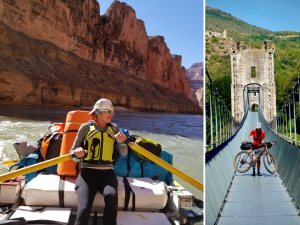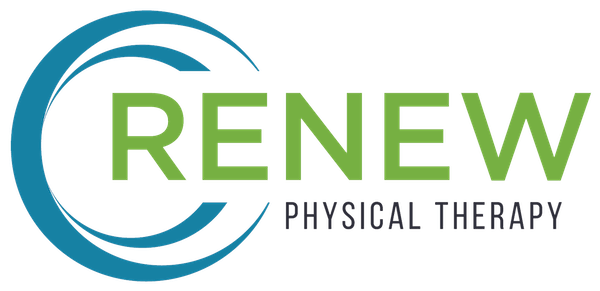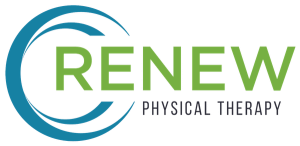
Warm summer months bring an increase in time spent outside. Hiking, biking, paddleboarding, kayaking, and boating are all common outdoor activities that Pacific Northwesterners flock to during the nicer weather. But functional exercise in an outdoor environment can be a lot different than the controlled parameters of an indoor or at-home gym, which may lead to injury. Renew Physical Therapy’s outdoor enthusiast, Lynn Dettinger, PTA, tells us how to best handle being active outdoors this summer.
Q: What outdoor activities pose the biggest risk for injury and how can I reduce this risk?
A: With every sport, it’s important to measure and manage the risk. Part of this process includes assessing your skill and experience relative to the objective. For example, before heading to the backcountry for a spring ski tour, or a climb up one of our peaks, skiers and climbers study the chosen route, the terrain, and snow and avalanche conditions. We also equip ourselves with avalanche beacons, shovels, and other safety gear and have the skills and experience to use this equipment in the event of a fall. Skiers also assess their strength and skill relative to the terrain and conditions.
While I try to measure and manage risk, sometimes I get the better of myself and decide to do something I’m not ready for. That’s when it’s nice to have rational friends and partners who know your skill level and experience in the outdoors. It’s always best to listen to the perspective of your companions, go into the day with eyes wide open, and not put others in danger.
Q: What should I do for a warmup and cool down and why are those aspects important?
A: Everyone needs their own personal warmup routine that fits their sport and body. Dynamic warmups are preferred over passive stretches. I like simple things like leg swings, hip openers, or arm swings. I try to remind the small stabilizer muscles, like our rotator cuff and gluteus medius, to come online.
Often, we drive to a trailhead, load up our packs and hit the trail with little time for a proper warmup. Starting out slowly and letting your heart and muscles adapt works well in these situations.
After intense exercise, we should go into some kind of recovery like easy spinning, slow jogging, chill strokes in the pool or lake, etc. This is not just because it feels good, the cooldown is active recovery and is even more essential for women, since we experience a greater decrease in arterial blood pressure after exercise than men. With an active cooldown, your body gradually brings down the heart rate, clearing lactate from the blood, and reducing the acute decrease in your immunity.
In the summer, we often spend days in the wilderness backpacking, climbing or bike packing. Endurance training in the off season prepares us for multi-day trips, but taking time to stretch before climbing in the tent to sleep always makes the next day’s journey more enjoyable.
Q: How does my core, hip, and lower back strength impact my ability to participate in outdoor sports/activities?
A: Trunk and core stability and strength protect your extremities from injury. Your core is the solid platform that allows our legs to move up and over unstable ground with more confidence and speed. A strong core protects your spine from injuries and back pain and makes carrying loaded backpacks for days possible. Many summer activities require endurance, and the more stability and strength an athlete has, the more fun they will have. For example, river and sea kayaking requires core and trunk strength, an upright seated posture, and strong hips to push against. Our relatively small shoulder muscles fatigue quickly and are no match for the Puget Sound and wild Pacific. Strength coupled with endurance and some good technique gives the water athlete a bit more confidence and insurance if some unplanned weather event comes in or another emergency changes the day’s plan.
Q: What are three exercises I can do to maintain the strength needed for outdoor sports/activities?
A: There are many answers to this question and we’re all so different. Some have strong hips and quads but weak stabilizers. Some of us sit too much and lack strength up and down the posterior chain. Physical therapists are masters at finding your weaknesses and addressing them with specific exercises. On a more basic level, humans push, pull, squat, lift and rotate. The three exercises that cover the basics and include core are squats, pushups, deadlifts with some press ups or pull ups for dessert. Every summer sport requires strength, mobility, and balance. Maintaining these through single leg squats or deadlifts has immediate and long-term payoff.
Q: How can a physical therapist help me if I am injured or want to prevent injury as we get into spring/summer months?
A: Physical therapists are experts at designing exercises that combine strength, mobility, and balance. Physical therapists also coach their clients through specific movement patterns and correct and re-educate the brain/body connection along the way. Relearning inefficient movement patterns prevents us from reinjuring the same shoulder or knee over and over. For example, if I injure a shoulder and lose my range of motion, one of my Renew physical therapists will provide me with a routine of progressively more difficult but appropriate exercises while the muscle or ligament heals. They will also retrain my funky posture along the way making it less likely for me to reinjure the same shoulder muscle.
Another cool advantage to seeking care with Renew’s physical therapists is they have sport-specific superpowers. For example, Kyle Mendes specializes in the Golf Rehab program, Erin Peterson loves to train and rehab a throwing arm, Sarah works with gymnasts, and all of the physical therapists take their injured athletes through a rigorous back-to-sport protocol to ensure the athlete can return to their sport with confidence. The bottom line is if you are an athlete, you will probably get injured eventually. Having a relationship with a physical therapist before or after that injury is your best route back to your sport.
To learn more and book an appointment with a Renew physical therapist, visit our website at https://renew-physicaltherapy.com.


